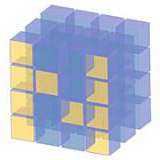 |
Visual Studio 2017 Edition |
|---|
It's hard. It's always hard the first time you do something. Especially when you are collaborating, making mistakes isn't a comfortable thing. But open source is all about collaboration & working together. We wanted to simplify the way new open-source contributors learn & contribute for the first time.
Reading articles & watching tutorials can help, but what comes better than actually doing the stuff without messing up anything. This project aims at providing guidance & simplifying the way rookies make their first contribution. Remember the more relaxed you are the better you learn. If you are looking for making your first contribution just follow the simple steps below. We promise you, it will be fun.
If you don't have Visual Studio 2017 on your machine, install it.
Fork this repo by clicking on the fork button on the top of this page. This will create of copy of this repository in your GitHub account.
GitHub keeps track of the relationship between your repo and the one you forked it from. You can think of your repo as a working copy.
Most top-level GitHub repos (i.e. they are not forked from any other repo) have a small core team of people who can directly commit changes. All other contributors must fork the repo and make changes in the fork, then create a Pull Request to ask for their changes to be merged back into the primary project. If the project owner likes the changes they will be merged. More on how to do that later.
The next step is to clone your repo down to your machine so you can begin making changes. Visual Studio needs the URL of your repo, so click the clone button and then click the copy to clipboard icon.
CAREFUL: One mistake new contributors often make is to clone the repo you forked from rather than cloning your repo. Check your browser's address bar and make sure you are cloning your repo.
It is now time to jump in to Visual Studio 2017! You will be working in the Team Explorer tab for most of this tutorial. If it is not open by default, click View > Team Explorer to open it.
Team Explorer has many views and there are navigation buttons located at the top to help you find the different areas. To clone a repo, you need to be on the Connect view, which should be the default. If you do not see the clone button, click the green plug at the top.
Click the Clone option under Local Git Repositories and paste the URL to your repo in the text box. This should be the URL you copied to your clipboard from GitHub previously.
Click the Clone button to initiate the process.
When the process is complete you will be moved over to the Solution Explorer tab where you can see the contents of your repo. Yours will look different than the screenshot below because things change!
Click back to the Team Explorer tab and use the main navigation dropdown to open the Branches view.
You should see the first-contributions repo and the default branch, which is called master. Right-click on master and choose New Local Branch From....
Give your branch a name like add-<your_name_here>, for example: add-alonzo-church.
Leave the Checkout branch box checked and click the Create Branch button.
You should see your new branch in the list.
Open Contributors.md and add your name to the end of the list. This file contains GFM (GitHub Flavored Markdown) which is a proprietary flavor of the markdown syntax.
Copy one of the other contributors' lines and modify it with your name to make sure you get the syntax right - it can be picky.
TBD
If you go to your repository on github, you'll see Compare & pull request button. click on that button.
Now submit the pull request.
TBD
 |
|
|---|---|
| Command Line | GitHub Desktop |
You will find many beginner-friendly issues on: contributor.ninja.
Here's some beginner level issues in popular repos that you can solve. Go ahead and go to those repos to learn more















